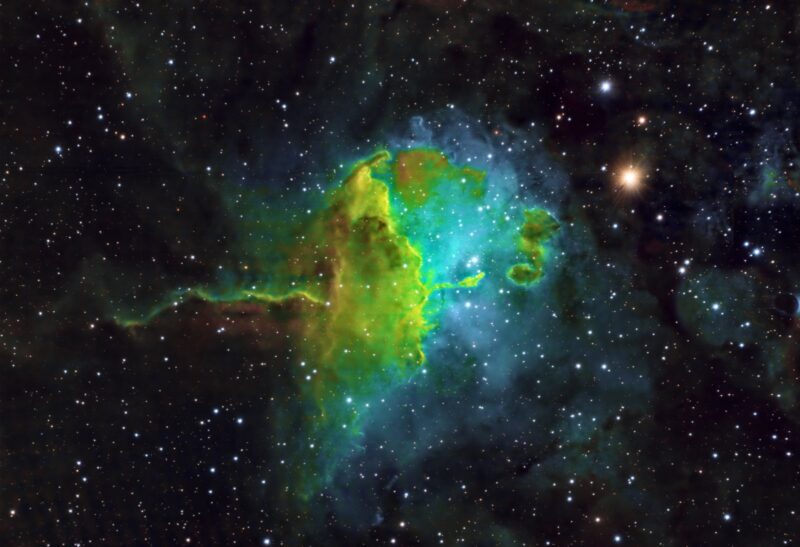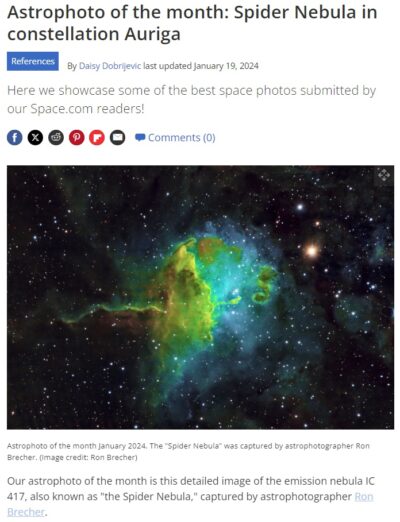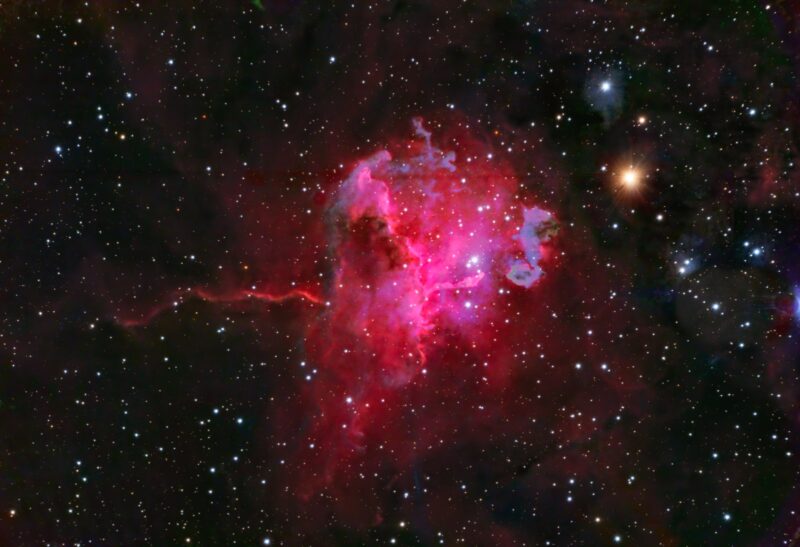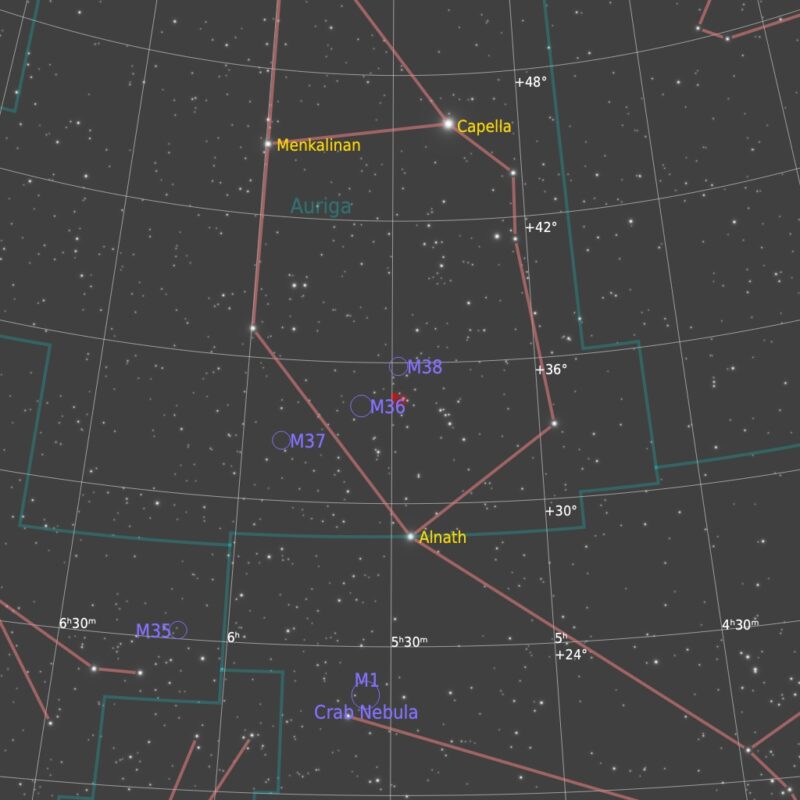IC 417, The Spider Nebula
 Click images for full size versions
Click images for full size versions
January 13, 2024; Image of the Month (1/24) at Space.com
 IC 417 is an emission nebula in the constellation Auriga, lying about 10,000 light years away. The glowing centre of the nebula is energized by the hot, massive blue stars embedded within. New stars are being formed in the ovals above centre and the surrounding bluish nebula above-left of centre. This nebula is informally known as The Spider Nebula. I have imaged this in a much wider field.
IC 417 is an emission nebula in the constellation Auriga, lying about 10,000 light years away. The glowing centre of the nebula is energized by the hot, massive blue stars embedded within. New stars are being formed in the ovals above centre and the surrounding bluish nebula above-left of centre. This nebula is informally known as The Spider Nebula. I have imaged this in a much wider field.
Tekkies:
Acquisition, focusing, and control of Paramount MX mount with N.I.N.A., TheSkyX and PHD2. Primalucelab low=profile 2″ Essato focuser and ARCO rotator. Equipment control with PrimaLuce Labs Eagle 4 Pro computer. All pre-processing and processing in PixInsight. Acquired from my SkyShed in Guelph. Average transparency and seeing. Data acquired under moderate moonlight between November 15 – 20, 2023.
Celestron 14″ EDGE HD telescope at f/11 (3,912 mm focal length) and QHY600M camera binned 2×2 with Optolong filters.
9x5m Red = 0hr45m
10x5m Green = 0hr50m
10x5m Blue = 0hr50m
29x5m Ha = 2hr25m
14x5m O3 = 1hr10m
12x5m S2 = 1hr00m
Total: 7hr00m
Preprocessing: The WeightedBatchPreProcessing script was used to perform calibration, cosmetic correction, weighting, registration, local normalization and integration of all frames.
Colour master: A colour master was made from the Red, Green and Blue masters using ChannelCombination in RGB mode.
Gradient Removal: DynamicBackgroundExtraction was applied to the RGB and narrowband masters.
Deconvolution: BlurXterminator was used on the RGB masters with Automatic psf with “Correct Only” selected.
Colour Calibration: ColorCalibration was used to calibrate the RGB master.
Deconvolution: BlurXterminator was used on the RGB and narrowband masters with default setting.
Star Removal: StarXterminator was used to remove the stars from each of the RGB and narrowband masters, with default settings. Only the RGB stars-only image was preserved.
Linear Noise Reduction: NoiseXterminator was applied to the RGB and narrowband masters with settings Amount=0.9 and Detail=0.35
Hubble Palette master: A SHO master was made from the S2, Ha and O3 masters using the NBColorMapper Script.
Stretching: HistogramTransformation was applied to the RGB, Ha and SHO masters to make pleasing images. Approximate background level after stretch was 0.10 for RGB and 0.08 for the narrowband masters.
Nonlinear Processing
HaRGB Image Creation: PixelMath was used to blend Ha into the RGB image using the following expression with parameter values a=1.2 and b=0.1.
Red: max($T[0], a*Ha)
Green: $T[1]
Blue: iif($T[0]<a*Ha, $T[2] + b * Ha, $T[2])
Nonlinear Noise Reduction: NoiseXterminator was used to reduce noise in the background areas of the HaRGB and SHO images with settings Amount=0.9 and Detail=0.2
Contrast Enhancement: LocalHistogramEqualization was applied three times to the HaRGB and SHO images. A Contrast Limit of 1.5 and 1 iteration was used for each LHE application (scale 20, strength 0.35; scale 90, strength 0.25; scale 150, strength 0.15).
Sharpening: A mask was used to select brighter regions of nebulosity in each image for sharpening with MultiscaleMedianTransform (Layers 1 – 5 with strengths of 0.03, 0.05, 0.08, 0.06, and 0.03, respectively).
Brightness Enhancement: Using a mask to protect the background, the nebula was brightened in each images with ExponentialTransformation and CurvesTransformation.
Stars-only steps: MorphologicalTransformation was used in Morphological Selection mode to shrink the stars through a mask made by extracting the Luminance from the stars-only image. CurvesTransformation was used to add saturation to the stars.
Hubble Palette Colour Adjustments: CurvesTransformation was used with the Hue tool to adjust the colour tones in the SHO image.
Star Restoration: PixelMath expression combine(starless, stars, op_screen()) was used to combine the RGB stars-only image with the HaRGB and SHO images created with StarXterminator.
Final Steps: Background, nebula and star brightness, contrast and saturation were adjusted in several iterations in each image using CurvesTransformation with masks as required. ICCProfileTransformation (sRGB IEC61966-2.1; Relative Colorimetric with black point compensation) was applied prior to saving as a jpg. The finder chart was made using the FindingChart process.








Leave A Comment